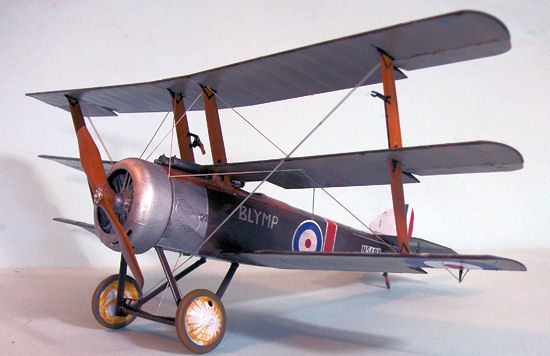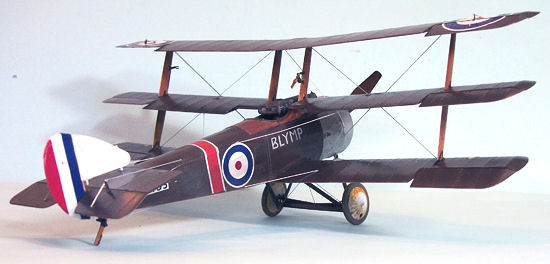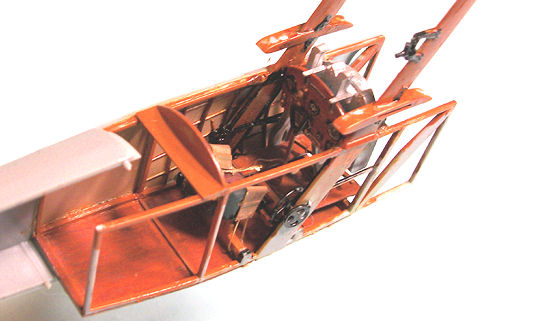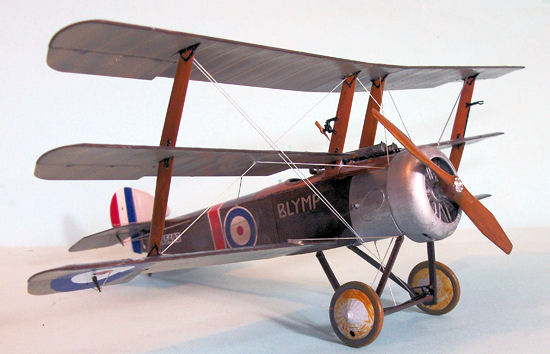
| KIT #: | 32008 |
| PRICE: | $69.00 includes shipping |
| DECALS: | Five options |
| REVIEWER: | Tom Cleaver |
| NOTES: |

| HISTORY |
The Sopwith Triplane ‑ known to its Royal Naval Air
Service pilots as the “Tripehound” ‑ was developed from the biplane Pup in late
1916.
The purpose of the triplane configuration was to maximize pilot view
with narrow‑chord wings and maximize maneuverability by increasing wing area
without increasing wingspan.
The result was a supremely maneuverable single‑seat
scout that had such a profound effect on its opponents that they paid it the
ultimate compliment of copying it ‑ directing all German aircraft manufacturers
to submit designs for triplane fighters within weeks of the appearance of the
Tripehound over the Western Front in the Spring of 1917.
The Triplane was generally about 15 m.p.h. faster than
the Albatros D.
 Flown by such famous RNAS pilots as the Canadian Raymond
Collishaw,
American O.C. “Boots” LeBoutillier, Englishman Reggie Soar, and
Australian Bob Little, the Sopwith Triplane went far to re‑establish British air
superiority in the northern region of the Western Front following the disaster
of “Bloody April.”
Powered by the 110 h.p. Clerget engine, the fighter
suffered from a standard armament of only one Vickers machine gun, though both
Collishaw and Bob Little flew a limited‑production series of Triplanes armed
with two machine guns despite the deleterious effect on performance from the
extra weight of the additional weapon even when powered by the 130 hp Clerget.
Flown by such famous RNAS pilots as the Canadian Raymond
Collishaw,
American O.C. “Boots” LeBoutillier, Englishman Reggie Soar, and
Australian Bob Little, the Sopwith Triplane went far to re‑establish British air
superiority in the northern region of the Western Front following the disaster
of “Bloody April.”
Powered by the 110 h.p. Clerget engine, the fighter
suffered from a standard armament of only one Vickers machine gun, though both
Collishaw and Bob Little flew a limited‑production series of Triplanes armed
with two machine guns despite the deleterious effect on performance from the
extra weight of the additional weapon even when powered by the 130 hp Clerget.
Such was the pace of technical development that the Triplane,
which first appeared at the Front in February and only achieved widespread
service in all four RNAS fighter squadrons ‑ Naval 1, Naval 8, Naval 9 and Naval
10 ‑ by May, was considered obsolescent by late July and left front‑line service
by the end of August, 1917.
Replaced by the tricky Sopwith Camel, the Tripehound was
remembered by its pilots as a wonderful flying machine.
It was far superior to the better‑known Fokker Triplane,
which suffered from only having ailerons on the upper wing, unlike the
Tripehound which had ailerons on each wing and could fly rings around Fokker's
product.
Robert Alexander Little ‑ The Australian Ace of Aces:
I am frequently struck when I read about the various aces of the
First World War by how much they are the personification of certain national
stereotypes. Raymond Collishaw could never have been other than a Canadian, von
Richtofen a Prussian, Guynemer or Fonck French, Rickenbacker or Luke an
American.
Reading about R.A. “Bob” Little, he comes across to me as the
quintessential Australian.
Born in
 He was sent to the Naval Air Station at
He was sent to the Naval Air Station at
As the new German Jastas
with their Albatros fighters appeared on the Western Front in the fall of 1916
and the British lost air superiority over the lines, the RNAS was drawn into the
land battle to support the RFC, forming fighter squadrons at Dunkirk to fight
under RFC command.
“Naval Eight” ‑ No. 8 (Naval) Squadron ‑ was formed on
October 25, 1916, with Little among its first pilots, assigned to "B" Flight
under the command of another Australian, Stan Goble. Commanded by Squadron
Commander G. R. Bromet, Naval Eight operated three flights of Nieuport 17s,
Sopwith 1 1/2 Strutters and Sopwith Pups. That December, Naval Eight became the
first all‑Pup squadron in action.
Little scored his first victory, an Aviatik C.1, while flying Pup
N5182, scoring a second two‑seater just north of La Bassee on November 23. By
mid‑December he claimed two Halberstadt D.IIs, to become one of the leading
scorers in the unit. On February 1, 1917 Naval Eight transferred their Pups to
No. 3 (Naval) Squadron, while Naval Eight re‑equipped at Dunkirk with the new
Sopwith Triplane. They re‑entered operations in late
March on the Third Army Front near Arras. Their main
opponents were von Richthofen's Jasta II, equipped with the Albatros D.
Due to delays in introducing the new 1917 designs, RFC squadrons
were being run through the meatgrinder in the Spring of 1917 as D.H.2s and
F.E.2b's and F.e.8s went up against the new Albatros D.
 On April 24, he attacked a DFW C.V, putting a bullet
through its oil tank, then followed it as it landed on a field behind Allied
lines. The DFW made a perfect landing, but when Little attempted to land and
take them prisoner, his Triplane turned over on landing.
As the
German pilot, Leutnant
Friedrich Neumuller ‑ who had been a Rhodes scholar at Oxford before the war ‑
helped Little out of the overturned Triplane, he remarked, “It rather looks as
if I have brought you down, not you me, doesn't it?”
On April 24, he attacked a DFW C.V, putting a bullet
through its oil tank, then followed it as it landed on a field behind Allied
lines. The DFW made a perfect landing, but when Little attempted to land and
take them prisoner, his Triplane turned over on landing.
As the
German pilot, Leutnant
Friedrich Neumuller ‑ who had been a Rhodes scholar at Oxford before the war ‑
helped Little out of the overturned Triplane, he remarked, “It rather looks as
if I have brought you down, not you me, doesn't it?”
By May, Little had hit his stride.
He had modified Triplane N5493 ‑ one of a limited
production run of triplanes distinguished by a twin‑Vickers armament‑ by moving
the seat forward 10 inches.
This made the airplane nose‑heavy and increased its
diving speed, which was crucial for Little who initiated his battles with a fast
dive into the middle of an enemy formation.
Named “Blymp” for his son who had been born the year
before, N5493 was unflyable to other pilots due to its seating configuration
which put it out of rig. By May 26, his tally stood at 20. He was relentless in
battle, closing to within 15‑20 feet of an opponent before opening fire.
A crack shot, he would only break off a fight when he
had exhausted his ammunition.
On June 26, Little attacked another Aviatik C.V, flown by pilot
Gefreiter Ernst Bittorf and observer
Leutnant Karl Schweizer of
Flieger Abteilung 269.
Little wrote in his report, “I stalled up and fired a
burst of 20 rounds at a range of 50 yards.
The Hun Aircraft stalled and dived west... it dived past
the vertical and came back east on its back.
Something then
fell out ‑ I think it was a man... I caught up with it and saw a man crawling
along the fuselage, trying to get to the bottom (the machine was still on its
back and was now on fire). I closed and fired about 20rounds and the man fell
off. The machine carried on down to about 180 feet where it broke up and
crashed.”
Fellow Naval Eight ace Reggie Soar wrote of Little: “On the Somme
Front, he was immediately successful in fights in the air as he was with tricks
on the ground.
For example, the pilots would often take a tender into Amiens for
dinner at the Godbert.
Very often we would get stuck behind a car full of
French officers en route, who would not give way... Little would pull out his
revolver and shoot a nice round hole in the rear tyre of their tourer.
He never missed! He was an outstanding shot with both
revolver and rifle, and a collector of wild flowers.
He had few equals in air fighting, and though not a
polished pilot, he was one of the most aggressive.”
R.J.O. Compston, Little's commanding officer, wrote of him, “Once
Little came within range of an enemy he did not give up until, first, the enemy
was shot down, secondly his own engine failed, or thirdly, he ran out of
ammunition.
He had in human guise the fighting qualities of a bulldog.
He never let go.”
 Little scored his last Triplane victory on July 10, for a total
of 27 since April 7.
“Blymp” was the second most‑successful Triplane after
Collishaw's “Black Prince,” N5492.
Little scored his last Triplane victory on July 10, for a total
of 27 since April 7.
“Blymp” was the second most‑successful Triplane after
Collishaw's “Black Prince,” N5492.
Little was pulled out of combat in August, but got
himself posted to “Naval Three” ‑ later 203 Squadron RAF, commanded by Raymond
Collishaw. On April 21, 1918, the
day von Richthofen was killed, Little picked off “tail‑end
Charlie” of a formation of twelve from Jasta Boelcke.
Six Fokkers turned on Little's Camel and shot away his controls.
The Camel dove to less than 100 feet of the ground
before flattening out with a jerk. Little, who had unstrapped his seat belt, was
thrown clear as the Camel ploughed into the ground north of the Forest of Nieppe.
When two enemy aircraft dove to strafe the wreck, Little blazed away with his
pistol until he was joined by British infantry with Lewis guns.
On the morning of May 28, 1918, Major Booker ‑ Little's comrade
from Naval Eight and now Officer Commanding 201 Squadron - was summoned to where
a Camel had crashed in the French lines. The pilot, still at the controls with a
bullet through his heart, was Little. He had taken off the previous evening to
intercept German Gothas, and was apparently killed by one of the gunners.
Bob Little had a score of 47 at the time of his death ‑ 4 in
Pups, 27 in his Triplane, and 16 in Camels ‑ making him the Australian Ace of
Aces in all wars. He was buried in Wavans cemetery.
| THE KIT |

| CONSTRUCTION |

| COLORS & MARKINGS |

I used the kit decals for the national insignia since
they were already separated for the ailerons.
I used the Pheon Decals to do the individual markings
for “BLYMP,” the Triplane flown by Bob Little.
When all had set up, I gave the model a coat of
Xtracrylix ”Satin,” followed by a thin coat of Xtracrylix “Flat.”
| FINAL CONSTRUCTION |
I attached the forward cowling panels, using the ones
with the correct inspection door per a photograph of the actual airplane.
I then used thinned Tamiya “Smoke” applied with a 1/4
inch flat tip brush to the fuselage sides and lower surface and
 the
inner surfaces of the lower and middle wings, to simulate the staining from the
oil thrown by the engine.
I also applied this to the completed engine and to the
firewall and cowling parts.
I also “muddied” the wheels and applied “mud spray” to
the lower wing lower surface.
the
inner surfaces of the lower and middle wings, to simulate the staining from the
oil thrown by the engine.
I also applied this to the completed engine and to the
firewall and cowling parts.
I also “muddied” the wheels and applied “mud spray” to
the lower wing lower surface.
The wing assembly was considerably easier than any other
Sopwith Triplane model I have built, because the outer struts are in two parts.
One attaches the lower strut section to the lower wing,
then attaches the middle wing, then attaches the upper strut section to the top
of the middle wing, and then the upper wing.
With the strong structure created by the cockpit
assembly, and the positive attachment of the wing struts to their positions, it
is impossible to get the assembly out of alignment.
I then attached the ailerons in a “dynamic” position.
| CONCLUSIONS |
Another Wingnut winner.
The kit is easy to assemble and results in a
good-looking model.
Given that I recently saw a Roden kit for sale at the
LHS for UD$75.00, the Wingnut price of US$69.00 for this kit ends any question
of which is the better value. Comparing
the Wingnut Wings Triplane to the Roden model reveals the difference between a
diamond and a zircon.
Any modeler who has done any of these kits will have no
problem with this Triplane kit, and the resulting model looks wonderful sitting
next to all the others.
Highly recommended for World War I modeling fans.
Review kit courtesy
of
Wingnut Wings.
Order yours at
If you would like your product reviewed fairly and fairly quickly, please contact the editor or see other details in the Note to Contributors.